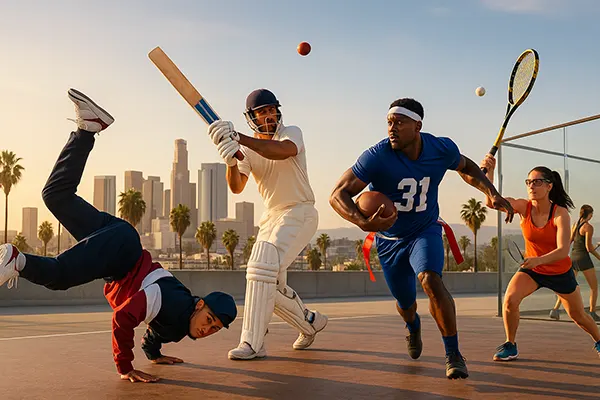The Summer Olympic Games in Los Angeles in 2028 are set to become one of the most diverse and innovative editions in the history of the competition. The International Olympic Committee (IOC) has confirmed several new disciplines that reflect modern sporting trends, cultural influence, and the preferences of younger generations. These additions aim to make the Games more relevant to today’s global audience while maintaining the traditional values of the Olympic movement.
Breaking into the Olympic Spotlight
One of the most anticipated inclusions is breakdancing, officially referred to as breaking. After its successful debut at the Youth Olympic Games in Buenos Aires in 2018 and its upcoming presence in Paris 2024, the discipline will continue its journey in Los Angeles. Breaking combines athleticism, artistry, and cultural roots, making it a unique sport that appeals to both sports enthusiasts and urban culture communities worldwide.
The competition will feature one-on-one battles where athletes, known as B-Boys and B-Girls, will demonstrate strength, creativity, musicality, and stamina. Judges will evaluate routines based on originality, technique, and overall performance, ensuring that every battle tells a story beyond physical movement.
The decision to include breaking not only highlights the global recognition of street culture but also provides an opportunity for young athletes to compete at the highest level in a sport that originated from grassroots communities. It is a significant moment for the Olympic Games, bridging the gap between tradition and contemporary trends.
The Cultural Impact of Breaking
Breaking is more than a sport—it is a form of cultural expression. Its roots trace back to the Bronx in the 1970s, where it developed as part of the hip-hop movement. Over decades, it grew into a global phenomenon, and its Olympic recognition marks a milestone in the legitimisation of urban culture within traditional sporting frameworks.
For Los Angeles, a city with a rich history in hip-hop and street art, hosting breaking competitions will resonate deeply with local communities. It also reflects the Olympic spirit of diversity, inclusivity, and global representation, as breaking continues to thrive across continents, from Asia and Europe to Africa and the Americas.
The inclusion of breaking is expected to attract a new generation of spectators, particularly younger audiences who are passionate about music, dance, and creativity. It represents the IOC’s strategy to ensure the Games remain relevant and engaging in a rapidly evolving cultural landscape.
Cricket Returns After More Than a Century
Another headline-making decision is the return of cricket to the Olympic Games for the first time since 1900. The format chosen is Twenty20 (T20), the shortest and most dynamic version of the game, which is widely popular across South Asia, Australia, the United Kingdom, and increasingly in the United States. With cricket’s immense global fan base, this move is expected to significantly boost viewership and international engagement.
Six-team tournaments for both men and women will be held, giving cricket an equal footing with other established Olympic sports. This inclusion acknowledges the sport’s worldwide following, particularly in countries like India, Pakistan, and Bangladesh, where cricket is deeply embedded in national culture and identity.
Los Angeles provides a strategic location for cricket’s Olympic comeback. The United States has recently shown growing interest in the game, with new domestic leagues and stadiums being developed. The Olympic spotlight could accelerate cricket’s expansion in North America, creating lasting effects beyond 2028.
The Global Reach of Cricket
Cricket is played by more than 100 countries, with billions of fans across the globe. Its inclusion in the Olympics ensures representation for vast populations that have historically been underrepresented in the Games. It is also a unifying sport, bringing together diverse communities under the shared excitement of international competition.
The T20 format was chosen because it fits within the Olympic schedule, offering fast-paced matches that are accessible to audiences unfamiliar with the traditional, longer forms of cricket. The structure provides thrilling entertainment while retaining the core skills and strategies of the sport.
The addition of cricket also aligns with the IOC’s goals of expanding the Games’ international appeal. By welcoming a sport with such a massive global following, Los Angeles 2028 could set new records for worldwide viewership and participation.

New Additions: Flag Football, Lacrosse, and Squash
Beyond breaking and cricket, the 2028 Games will also feature three more exciting inclusions: flag football, lacrosse, and squash. Each of these sports brings unique characteristics and reflects efforts to diversify the Olympic programme.
Flag football, a non-contact version of American football, is set to make its Olympic debut in Los Angeles—a city synonymous with gridiron culture. This version focuses on speed, strategy, and teamwork without the physical risks of traditional football, making it more accessible while still highly competitive.
Lacrosse, often described as North America’s first sport due to its Indigenous origins, will return to the Olympics after more than a century. Its inclusion highlights cultural heritage while also showcasing a sport that has rapidly grown in popularity worldwide. Meanwhile, squash, long campaigned for by its global community, will finally earn Olympic recognition, providing elite athletes the chance to compete on the biggest stage.
The Impact of These Emerging Sports
Flag football is expected to attract a large American audience and generate new interest abroad, particularly in countries where the National Football League (NFL) has been expanding its influence. The NFL has been a strong advocate for the sport’s inclusion, and Los Angeles offers the perfect backdrop for its debut.
Lacrosse’s return to the Olympics carries symbolic importance, as it is deeply tied to Native American history and identity. The sport’s modern international presence demonstrates how cultural traditions can evolve into global competition. Its recognition at the Games will also provide a platform to honour its heritage and growth.
Squash’s long-awaited inclusion rewards decades of campaigning by athletes and federations. Known for its intensity, agility, and endurance, squash has a strong global community and professional circuit. By joining the Olympic programme, it gains the opportunity to reach new audiences and inspire future generations of players.
